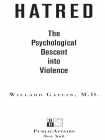Hatred, Willard Gaylin [best ebook for manga txt] 📗

- Author: Willard Gaylin
Book online «Hatred, Willard Gaylin [best ebook for manga txt] 📗». Author Willard Gaylin
As the history of Yugoslavia demonstrates, in many cases the confluence between territory and ideology makes any exact differentiation arbitrary. Often, an ideological difference will simply serve to fulfill material desires. One would have to be a sophisticated theologian to detect any life-threatening or otherwise profound differences between the Roman Catholic and Greek Orthodox theologies. History had imposed a different identity on these ethnically similar Slavs. Religious identity, not ethnicity, sustained the Slavs’ sense of enmity over the centuries. Religious differences became fused with differing political ideologies in the Balkans. The recent Serbian slaughter of the Bosnian Muslims was entirely territorial. The ideologies helped to demonize the Muslims and justify the genocidal slaughter that followed. The ideologies masked a pure grab for territory.
Ideological enemies can best be examined when no territory or national interest is present to obfuscate the issues—when the politics are removed and the passion is focused. In this case it is easier to turn to such groups as the antiabortion fanatics, the radical animal rights activists, and the extreme environmental-protection movements, groups that bomb and kill in the service of some ideological principle that transcends all others. They have subordinated all other moral commitments to their one moral crusade.
In my research for this book, I visited many of the websites of radical reformist groups in an attempt to understand the motivation and means for forming ideological communities. I started with simple causes, usually single-issue groups. Specifically, I wanted to understand how groups that had been formed ostensibly out of compassion, to protect the helpless and abused—animals, children, nature—were so readily converted to a community of haters. How love of the victim became subordinate to hatred of those who do not share one’s belief.
Most right-to-lifers, animal rights people, environmental protection groups, while passionately devoted to their causes, would not commit acts of violence or condone such actions by others. Still, in their “righteous” indignation against the opponents, they set a climate of hatred and create a defined and legitimate community in which the paranoid can enlist. These groups offer the individual hater an outlet for his groundless hatred, a self-justifying rationalization for his frustration, and a group identity that generally eludes the isolated and mistrusting paranoid.
The websites are, I suspect, the domain of the fringe elements of movements, representing a radical minority. It is their personal agendas that preempt the true goals of their cause. In addition, these sites provide justification for the even sicker segment of their constituency—those who are actually prepared to do violence. These people, who are at the periphery of the movement, are not primarily motivated by the specific cause—say, their anxiety for despoilation of the earth—but rather by their need to find relief from perceived persecutions and humiliations. The rhetoric supplied them by the leadership has both a religious fervor and the absolute certitude of revealed truth. This messianic leadership supplies those struggling with personal demons a rational and noble reason to destroy innocent life, at the same time, relieving their internal conflicts.
These websites have become a nucleus for the formation of a community of haters. They are a haven for such paranoid psychotics as Theodore Kaczynski. The movement supplies a rationalizing factor that supports the psychotic’s delusional thinking. The rage he feels and the destruction he exercises are now justified as being in the service of some common good. What he is doing may seem evil but is actually “noble” and “proper,” “a service to morality.” This justification is confirmed by his allegiances.
Ted Kaczynski stated in court that he used information from the “Litha 1993” Earth First Journal to kill Thomas Mosser by sending a bomb to his home. His conviction that he was saving the entire world was sufficient justification for him to say in a letter to the New York Times, dated June 24, 1995, “We have no regret about the fact that our bomb blew up the wrong man, Gilbert Murray, instead of William Dennison, to whom it was addressed.”
Radical single-issue groups offer justification for personal paranoia by the extreme rhetoric of their publications. But a mass culture of hatred cannot possibly be composed entirely, or preponderantly, of madmen and psychopaths. These websites are capable of attracting and mobilizing hatred, but they are likely to draw into their webs only people previously disposed to hatred.
The antiabortion activists see abortion as infanticide. In their battle to save the innocent, the taking of a few less-innocent lives—doctors and nurses and parents ready to “kill” their own babies—seems to them a reasonable moral trade-off. In their perverse utilitarian thinking, they will have saved more lives than they have taken. Their current campaigns on the web employ the term “the abortion holocaust,” by which they choose to see direct equivalence between abortion and the Holocaust. They argue that while the Holocaust killed 6,000,000 Jews, since Roe v. Wade (1973), “28,000,000 unborn babies have been put to death by abortion in this country.”63 They believe they are fighting the just war, and under that aegis, the use of an atomic weapon to further their cause may be justified. They are free to kill the few to save the many. Incidentally, the Catholic church and the fundamentalist Protestant churches, whose philosophies underlie the right-to-life action groups, were not nearly so outspoken during the Holocaust. The passivity of Christian communities in the face of the Holocaust slaughter continues to be exposed in current studies and stands in sharp contrast to the passion with which they currently defend against abortion and even birth control.
Many animal rights activists perceive helpless animals as akin to innocent babies. Thus the life of a laboratory mouse is fungible with the





Comments (0)